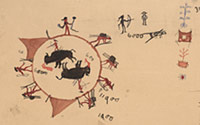3010 Schedule
A "winter count" was a Native American mnemonic device passed from one generation to another marked with pictographs that recorded noteworthy events in tribal life that took place each "winter" or year. Battiste Good, a Brulé Dakota living at the Rosebud Agency in South Dakota, probably made this winter count at the turn of the twentieth century based on original records kept on hides (he introduced Arabic numerals). Special characters denoted famines, the introduction of the horse, buffalo hunts, severe winter storms, smallpox epidemics, and other significant events. (Source:http://www.loc.gov/exhibits/treasures/trm054.html (Links to an external site.))
|
Week |
Readings |
Activities |
|
One – Introductions |
|
Introductions Computer Lab |
|
Two – Places |
|
Discussion: excerpt, “1491” Oral presentation #1 (informal): use one of the sources for the news from Indian Country. Find a topic; report for 2 minutes on the issues, persons, concerns expressed Oral presentation #2 (formal): Research a site in Indian Country which existed prior to 1492. Prepare a handout which locates the site on a map and cites your sources of information. Report orally for 5 minutes on the history and culture of the site. |
|
Discussion: Crosby, Heuval, “After the Mayflower” Oral presentation #3 (informal): Present a meal (breakfast or lunch) which you ate during the week. What were the geographical origins of the foods? Oral presentation #4 (formal): Read at least 2 origin stories -- consider main characters, relationships between humans and other creatures, the nature of this world. Prepare a handout in which you summarize the stories and cite your sources.. Response paper #1: Use the readings to answer the question Mann asks the scholars: Where would you rather have lived in 1491: Europe or the Americas? (draft for peer review due: February 3); final draft due: February 10) |
|
|
Four – Encounters |
|
Discussion: C-span interview, Facing East: Prologue – Chapter 3
|
|
Five – Encounters |
|
Oral presentation #5 (informal): present images of Natives by non-Native artists, pre 1800 Discussion: Facing East: Chapter 4 - Epilogue Response paper #2: Use the readings and other materials to explain: Native Americans during the colonial period are sometimes characterized as victims who succumbed to more powerful Europeans. Do you agree with this characterization? Be specific about strategies used by Natives. (peer review due: February 17, final draft due: February 24) |
|
Six – Losses |
|
peer review of paper #2 Oral presentation #6 (formal): present a Native voice of resistance (handout should include:
Discussion: Calloway, Kidwell, We Shall Remain, episodes 2 & 3 |
|
Seven – Holding the West
|
|
Discussion: Calloway, the artists, We Shall Remain, episode 4, Harper's articles |
|
Eight – Americanization
|
|
Oral presentation #7 (informal): report on a document in Calloway, 448-475 Response paper #3: With Indians confined on reservations, attempts by reformers and government officials to transform and assimilate Native people took new forms. Particularly devastating were renewed efforts to impose private property, new work regimens, different gender systems, the English language, and Christianity on American Indians. This social engineering-cultural, social, and economic colonialism-had a devastating impact, not only on Native societies and cultures, but materially on the larger Indian land base, as millions of acres were lost to Native people in the years following the General Allotment Act (or Dawes Act) of 1887. Indians themselves forged new ways to accommodate and resist this colonialism-including new pan-Indian organizations and prophetic movements-but the situation often proved grim during these late 19th-, early 20th-century years. Focus on one of these policies: allotments, boarding schools, denial of religious practices, leadership change. Describe and comment. (draft due March 3; final due March 17) Exam 1 - March 20, 21, 23, 24 MacKay's Study Session - March 21st, 8:00 AM Grounds for Coffee - 30th & Harrison |
Spring Break
Field Trip to Unitah & Ouray Reservation Links to an external site.- April . Meet at 7:30 AM in SBS parking lot. MacKay will bring food and treat you to lunch. Return before 5:00 PM
|
Nine – Uneven Ground |
|
peer review of paper #3 Discussion: Uneven Ground |
|
Ten – Uneven Ground |
|
Discussion: Uneven Ground |
|
Eleven – Self-Determination |
|
Discussion: Calloway, Wounded Knee"" |
|
Twelve – |
|
Oral presentation #8 (formal):present information about a contemporary Native American Artist. handout should include:
Oral presentation #9 (informal): NWT topic Discussion: Calloway Response paper #4: "Native Americans have not died out ' like snow before the sun,' nor have they 'vanished' into the melting pot of 'civilization.'" Using class materials, describe how you have come to an understanding that Indians exist in these times and that knowing about American Indians helps us know about all of us. In other words--how are you getting to Indian Country?(peer review April 14; final due: April 28) |
|
Thirteen |
|
peer review of response paper #4 Oral presentation #10 (formal): summarize and comment on 1 of the films in the Utah We Shall Remain series Handout should include:
Discussion: Calloway, More Than That: |
|
Fourteen
|
Book presentations Discussion: Smoke Signals |
|
|
Finals Week - Dinner at 5:00 -- Bombay Grill on Washington -April 28 |
||

